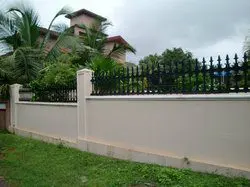Compound wall provides aesthetic appearance, privacy and security to your property. It prevents movements of unwanted objects in your property. It separates your property from neighbor’s property and gives a perfect demarcation to your property.

Types of Compound walls
There are different types of compound walls on the basis of appearance and construction material used.
- Masonry Compound Wall
- Ornamental Compound Wall
- Cladding Compound Wall
- Precast Compound Wall
- Security Compound Wall
1. Masonary Compound Wall
Masonary compound walls are typically constructed using Red clay bricks / Fly ash bricks, steel and cement mortar. Construction of compound wall start from 2 ft. below ground level so that the wall will get proper anchorage.
For Individual House Construction, the height of the masonry compound wall is usually between 5-6 feet and the thickness is usually 150mm (6 inches).
After excavation a PCC of 100 mm thick and 600 mm wide is laid to create an even surface on which the compound wall can be laid.
A rubble masonry of 450 mm width and upto 2 feet height is done below the brick wall to distribute the load of the structure built above.

Above rubble masonry, a RCC Coping of 4″ thick is made for a levelled surface and to transfer the loads of the compound wall to the substructure below.
Above RCC coping, masonry compound wall is constructed using 6”Red clay bricks or 4” Red clay bricks / flyash bricks. Intermittent brick coloums of 300mm X 230mm are constructed at a distance of 7 ft to 10 ft center to center and at the corners of the plot.
After curing of this masonry wall, cement plaster is applied on both the sides of compound wall and paint is applied.


Cost of a Masonary Compound Wall:
The cost of a typical masonry compound wall averages to Rs. 1200/Rft for 5 feet height structure and including a 8 Feet wide MS Gate on the front side.
The cost may vary +/-10 % depending on the availability of local materials like bricks, rubble etc., or necessarily of RCC because of site constraints
Bonus Tip: To increase the aesthetic appeal of a masonary compound wall you can make grooves in the plaster.
2. Ornamental Compound Wall
Ornamental Compound walls are a combination of masonry wall and MS grills/ SS grills. In this type of compound wall upto 3-5ft masonry wall is constructed with cement plaster and paint over it.
Above this masonry wall MS grills or SS grills are fixed as per decoration and security requirement.

Cost of Ornamental Compound Wall
Cost of these Ornamental Compound Walls vary heavily depending on the design of the grill and type of grill you choose above. The cost of an Ornamental compound wall is usually greater than a simple masonry compound wall.
The cost of an ornamental compound wall averages to Rs. 1500 per Rft considering masonry construction is upto 3 feet and a 2.5 feet height grill is installed over it. The cost includes a 8 Feet wide MS Gate also.
3. Cladding Compound Wall or Compound wall with Cladding
Cladding Compound wall are in which a cladding material (such as vitreous tiles, marbles, shera panels etc.,) are fixed over typical masonry wall giving a aesthetic appeal to it. These compound walls are usually done for High end bungalows.

Cost of a Compound Wall with Cladding
The cost of a cladded compound wall will be equal to the cost of masonary compound wall plus the cost of supply and installation of the cladding materials that is fixed on it.
Since the cost of cladding material varies hugely, the exact costing can only be determined once the type of cladding material is finalized.
Suppose if you are installing a stone cladding that costs Rs. 120 per sqft, then the cost of a 7 feet height compound wall shall be Rs. 2500 per Rft (considering stone cladding on outside portion only).
Planning to build a house in Bangalore?. Check for our House construction cost in Bangalore and outskirts upto 30 kms range.
4. Precast Compound Wall
Now days Precast compound wall is used in various places as they are very easy to install and it can be completed in very small time. But the strength and stability of the compound wall is a question.

Most of the manufacturers who claim to construct precast compound walls don’t provide proper foundation to the structure and the walls. This makes precast compound walls

Cost of a Precast Compound Wall
Since the precast compound walls are factory made and are transported to site, the overall cost is comparatively less as compared to masonry compound wall. The cost varies widely depending on the design and customisation required.
The cost of a precast compound wall typically starts from Rs. 90 per sqft (i.e., approximately Rs 600 per Rft) excluding MS gate.
This cost is usually charged by the precast manufacturer and doesn’t include the cost of foundation, painting, gate, any other finishings etc.,
So when you choose to calculate the cost of precast compound wall make sure you include all these in your overall costing.
If precast members area not handled properly during transportation and installation, it is very difficult to produce satisfactorily connections between the precast members.
5. Security Compound Walls
These type of compound wall are generally constructed at military base, government offices, police camps where security is main concern.

These type of compound wall have masonry wall with height more than 7 ft so that people cant climb easily on it. Usually a MS barbed wire fence or concertina coil is provided over these masonry wall. Alternatively in high security areas, the fencing is electrified to avoid any infiltrators.





